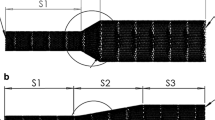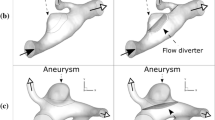Abstract
This paper presents a novel hybrid medical stent device. This hybrid stent device formed by fractal mesh structures provides a flow-diverting effect and stent-assisted coil embolization. Flow-diverter stents decrease blood flow into an aneurysm to prevent its rupture. In general, the mesh size of a flow-diverter stent needs to be small enough to prevent blood flow into the aneurysm. Conventional flow-diverter stents are not available for stent-assisted coil embolization, which is an effective method for aneurysm occlusion, because the mesh size is too small to insert a micro-catheter for coil embolization. The proposed hybrid stent device is capable of stent-assisted coil embolization while simultaneously providing a flow-diverting effect. The fractal stent device is composed of mesh structures with fine and rough mesh areas. The rough mesh area can be used to insert a micro-catheter for stent-assisted coil embolization. Flow-diverting effects of two fractal stent designs were composed to three commercially available stent designs. Flow-diverting effects were analyzed using computational fluid dynamics (CFD) analysis and particle image velocimetry (PIV) experiment. Based on the CFD and PIV results, the fractal stent devices reduce the flow velocity inside an aneurism just as much as the commercially available flow-diverting stents while allowing stent-assisted coil embolization.








Similar content being viewed by others
References
Armoiry X, Paysant M, Hartmann D, Aulagner G, Turjman F (2012) Interest of flow diversion prostheses in the management of unruptured intracranial aneurysms. Int J Vasc Med 2012:1–5. doi:10.1155/2012/654627
Henkes H, Bose A, Felber S, Miloslavski E, Berg-Dammer E, Kuhne D (2002) Endovascular coil occlusion of intracranial aneurysms assisted by a novel self-expandable nitinol microstent (neuroform). Interv Neuroradiol 8:107–120
Hurst D, Vassilicos JC (2007) Scalings and decay of fractal-generated turbulence. Phys Fluids 19:035103
Ikeda S, Arai F, Fukuda T, Negoro M, Irie K (2005) an in vitro patient-specific biological model of the cerebral artery reproduced with a membranous configuration for simulating endovascular intervention. J Robot Mechatron 17:327–334
Jeong W, Han MH, Rhee K (2013) Effects of framing coil shape, orientation, and thickness on intra-aneurysmal flow. Med Biol Eng Comput 51:981–990
Kojima M, Irie K, Fukuda T, Arai F, Hirose Y, Negoro M (2012) The study of flow diversion effects on aneurysm using multiple enterprise stents and two flow diverters. Asian J Neurosurg 7:159–165
Kojima M, Irie K, Ikeda S, Fukuda T, Arai F, Hirose Y, Negoro M (2012) The hemodynamic study for growth factor evaluation of rupture cerebral aneurysm followed up for five years. J Biomed Sci Eng 5:884–891
Lubicz B, Collignon L, Raphaeli G, Pruvo JP, Bruneau M, Witte OD, Leclerc X (2010) Flowdiverter stent for the endovascular treatment of intracranial aneurysms a prospective study in 29 patients with 34 aneurysms. Stroke 41:2247–2253
Lylyk P, Cohen JE, Ceratto R, Ferrario A, Miranda C (2002) Endovascular reconstruction of intracranial arteries by stent placement and combined techniques. J Neurosurg 97:1306–1313
Lylyk P, Miranda C, Ceratto R, Ferrario A, Scrivano E, Luna HR, Berez AL, Tran Q, Nelson PK, Fiorella D (2009) Curative endovascular reconstruction of cerebral aneurysms with the pipeline embolization device: the buenos aires experience. Neurosurgery 64:632–643
Mazellier N, Vassilicos JC (2010) Turbulence without Richardson–Kolmogorov cascade. Phys Fluids 22:075101
Mehta B, Burke T, Kole M, Bydon A, Seyfried D, Malik G (2003) Stent-within-a-stent technique for the treatment of dissecting vertebral artery aneurysms. Am J Neuroradiol 24:1814–1818
Nagata K, Sakai Y, Inaba T, Suzuki H, Terashima O, Suzuki H (2013) Turbulence structure and turbulence kinetic energy transport in multiscale/fractal-generated turbulence. Phys Fluids 25:065102
Nelson PK, Lylyk P, Szikora I, Wetzel SG, Wanke I, Fiorella D (2011) The pipeline embolization device for the intracranial treatment of aneurysms trial. Am J Neuroradiol 32:34–40
Otani T, Nakamura M, Fujinaka T, Hirata M, Kuroda J, Shibano K, Wada S (2013) Computational fluid dynamics of blood flow in coil-embolized aneurysms: effect of packing density on flow stagnation in an idealized geometry. Med Biol Eng Comput 51:901–910
Pedley TJ (1980) The fluid mechanics of large blood vessels. Cambridge University Press, Cambridge
Seoud RE, Vassilicos JC (2007) Dissipation and decay of fractal-generated turbulence. Phys Fluids 19:105108
Shapiro M, Babb J, Becske T, Nelson PK (2008) Safety and efficacy of adjunctive balloon remodeling during endovascular treatment of intracranial aneurysms: a literature review. Am J Neuroradiol 29:1777–1781
Szikora I, Berentei Z, Kulcsar Z, Marosfoi M, Vajda ZS, Lee W, Berez A, Nelson PK (2010) Treatment of intracranial aneurysms by functional reconstruction of the parent artery: the budapest experience with the pipeline embolization device. Am J Neuroradiol 31:1139–1147
Torii R, Oshima M, Kobayashi T, Takagi K, Tezduyar TE (2008) Fluid-structure interaction modeling of a patient-specific cerebral aneurysm: influence of structural modeling. Comput Mech 43:151–159
Torii R, Oshima M, Kobayashi T, Takagi K, Tezduyar TE (2009) Fluid-structure interaction modeling of blood flow and cerebral aneurysm: significance of artery and aneurysm shapes. Comput Methods Appl Mech Eng 198:3613–3621
Vanninen R, Manninen H, Ronkainen A (2003) Broadbased intracranial aneurysms: thrombosis induced by stent placement. Am J Neuroradiol 24:263–266
Acknowledgments
This research is partially supported by the Ministry of Education, Culture, Sports, Science and Technology grant-in-aid scientific research.
Author information
Authors and Affiliations
Corresponding authors
Rights and permissions
About this article
Cite this article
Kojima, M., Irie, K., Masunaga, K. et al. Hybrid stent device of flow-diverting effect and stent-assisted coil embolization formed by fractal structure. Med Biol Eng Comput 54, 831–841 (2016). https://doi.org/10.1007/s11517-015-1374-8
Received:
Accepted:
Published:
Issue Date:
DOI: https://doi.org/10.1007/s11517-015-1374-8




